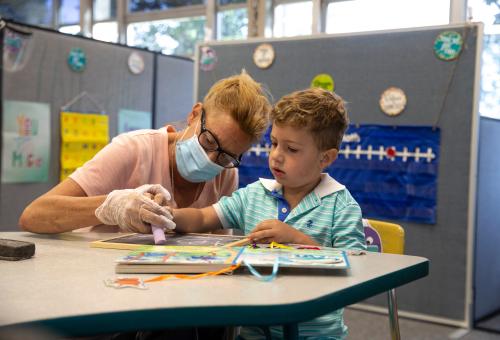As personalized learning research gains momentum, there is one big piece that has been missing from agendas. All leading definitions claim that personalized learning is primarily about addressing individual students’ needs.[1] For around a fifth of children in the U.S., key needs include health, food and housing.[2] But the emerging research on personalized learning shrinks this concept to entail only academic content needs, with the hypothesis that this can be met by progression based on mastery. While some narrowing is inevitable as the notion of personalized learning evolves, proponents need to keep one eye on potential decoupling of their stated aims and means. If personalized learning is going to have impact across the board, it will have to grapple directly with the fact that a lot of the needs children and young people bring into the classroom cannot be met by a new model of pacing.
This was the thinking of the Education Redesign Lab, a group at the Harvard Graduate School of Education led by former Massachusetts Secretary of Education Paul Reville, when they commissioned me to investigate what systemic strategies other countries had used to try to improve educational outcomes through personalization. The lab was interested in three specific types of strategies: personalizing learning through technology; promoting learning outside the classroom; and weaving health and human services into schools.
In the process of investigating this third strand, I conducted case studies of two major policy agendas in the U.K. that sought to rethink the relationships between children’s health, social, and educational services. These models could offer insights into how personalized learning could work more effectively in other countries, including the U.S.
The Every Child Matters program in England
The first of these case studies, Every Child Matters in England, is in fact the origin point of the concept of personalized learning. In the mid 2000s, personalization (or “personalisation”, as we Brits like to say) was top of the agenda in public services and became particularly prominent in education. For those who enjoy a blast from the past, some of this 10-year-old policy overview may sound familiar.
While Every Child Matters was a broad agenda, at its center was a multi-agency approach in which teachers as well as health- and social-service specialists work together to support children with multiple or complex needs. A shared set of outcome goals, a “Common Assessment Framework” (CAF), and “Team Around the Child” meetings provided the new norms and routines which aimed to bridge the divergent incentive structures and institutional cultures across services.
Every Child Matters was one of Tony Blair’s headline agendas, so when the Labour party succumbed to political headwinds in 2010, the phrase was swiftly wiped from websites. A planned rollout of an online version of the Common Assessment Framework, known as eCAF, was also scrapped. Aspects of multi-agency working have stuck, however, as an “Early Help Assessment” replaced the CAF, and many schools still hold Team Around the Child meetings.
In addition, by that point Scottish policymakers had picked up some of the tools. Where England had gone for a top-down national implementation, Scotland began by developing a full-fledged practice model in one local area, before moving to legislate multi-agency working under the banner of Getting it Right for Every Child (GIRFEC).
Results of a pilot program in Scotland
The Highland Council, a local district, was selected to develop the practice model. The central components again were a set of outcomes for children and tools for conducting assessments and joint meetings. They also went beyond health and social services, taking the time to get the local police, youth courts, and housing agency on board. The evaluation of the work in the Highland pilot found an increase in case conferences around children, but a considerable decline of children on the child protection register, implying that complex cases were being identified and handled earlier. They also saw improvement in academic outcomes for children in care.
GIRFEC implementation was not all smooth, however. The practice model introduced a new role in the “Named Person,” a professional (typically a school deputy principal) who would receive relevant information about a child; for example, if their family had been evicted or a health situation had changed. In Highland, they found this new role greatly helped to streamline communications and ensure that schools had all the relevant information about the students in their care. For a seemingly simple policy, however, the Named Person has proved the most difficult to implement, as it triggered a small body of concerted opposition to the notion that agencies could share information about a child or their family. Consequently, the legislation underpinning the Named Person has yet to be implemented. As almost any vision of personalized learning relies on schools knowing more about students, the Named Person controversy highlights that personalized learning advocates will have to tackle the issue of data sharing head on.
Despite this hold up, the other components of GIRFEC–and what remains of Every Child Matters–are entering their second decade, and represent a shift in institutional assumptions about the way that services work together around children. One current director of Children’s Services in England told me that he still uses the Every Child Matters outcomes as a mental framework when making decisions. In Scotland, as the GIRFEC practice model has spread nationally, it has been reinforced by alignment in inspection services, staff training, and infrastructure for data sharing.
The promise and problems of a multi-agency approach in America
Multi-agency working is not unheard of in the United States. Models such as City Connects or Communities in Schools have demonstrated that schools and community agencies working together can result in positive academic outcomes.[3] But the overall mixed picture that arises from evaluations only emphasizes the difficulty of making all the links from improved student health and safety to improved academic outcomes. Moreover, both City Connects and Communities in Schools rely heavily on philanthropic and school district dollars. In contrast, the agendas in England and Scotland were designed to unlock all the government-provided resources available for children and young people–otherwise trapped in siloed funds across health, housing, and social care–by ensuring that educators can get access to support and opportunities on students’ behalf at the right time.
Multi-agency agendas are particularly important in rural areas where smaller schools typically cannot afford to keep nurses, support specialists, or social workers on staff. One of the reasons the GIRFEC practice model was developed in Highland is that it is the district with the largest geographic area and a dispersed population. As I found when interviewing implementers in Highland and Edinburgh, the latter had access to a wide range of nonprofit organizations offering different forms of support, while the Highland team were much more reliant on public sector professionals. Rural areas typically have to work with what is assigned to them.
A national agenda like GIRFEC or Every Child Matters is unlikely to be the answer in the U.S., but states could do more to address how they coordinate efforts between their education, health and human services, and justice agencies. A CAF and common child outcome goals can provide the shared language that is necessary for multi-agency working. If these tools are tied into training and quality assurance, they start to take hold in daily practice. Then, even when political or philanthropic support falls way, there remains some basis for cooperation to get children what they need.
Footnotes
- Meeting student “needs” features prominently in the working definition of personalized learning created by advocates in 2014, and in the definition in the 2017 United States National Education Technology Plan.
- Each problem comes with more specific estimates: According to aggregated national data from 2005-2011, between 13-20 percent of U.S. children experience a mental health disorder in a given year. In a nationally representative survey of adolescent health, 19.2 percent of adolescents report unmet health needs. In 2016 Department of Agriculture data, 16.5 percent of U.S. households with children experienced food insecurity. Based on the American Housing Survey, around 40 percent of U.S. children (under age 17) are affected by high housing-cost burdens, crowded housing, or physically inadequate housing.
- City Connects results are published in Walsh, M. E. et al. 2014. “A New Model for Student Support in High-Poverty Urban Elementary Schools: Effects on Elementary and Middle School Academic Outcomes.” American Educational Research Journal 51 (4): 704–37.
The five-year quasi-experimental study of the Communities in Schools model of Integrated Student Supports (ISS) found that it decreased dropout and increased graduation. Subsequent studies found more mixed results. These studies were identified as part of a review of empirical literature underpinning the LEAP Personalized Learning framework, conducted on behalf of LEAP Innovations.







Commentary
Meeting children’s needs: An international perspective on personalized learning
March 1, 2018